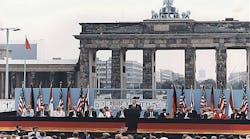The National Association of Manufacturers (NAM) today urged the U.S. government and other stakeholders to address trade barriers faced by manufacturers in the United States in markets around the world. In its detailed submission to the Office of the U.S. Trade Representative for its National Trade Estimate Report (NTE), the NAM described a wide variety of foreign trade barriers that undermine the ability of manufacturers in the U.S. market to compete on a level playing field in international markets, which in turn undermines U.S. economic opportunities here at home.
These trade barriers vary widely, but all have a significant impact on the ability of manufacturers in the United States to take full advantage of the opportunities provided by global markets and, in many cases, distort competition globally. The NAM’s submission identified a broad range of trade barriers, which the NAM has grouped into several major categories, including:
- Import policies, including high import tariffs, discriminatory import licensing schemes, and burdensome customs policies and procedures;
- Investment barriers, such as foreign investment bans or caps in some sectors, investment screening mechanisms and equity caps and investment-related localization/performance requirements;
- Forced localization barriers, including measures designed to boost or defend domestic industries, investors, and intellectual property over their foreign counterparts;
- Lack of intellectual property protection and enforcement, such as lax enforcement against counterfeiting and piracy, unwarranted requests from government entities for confidential business information, and compulsory licensing regimes;
- Standards and technical regulations, including unique regulatory and technical standards and conformity assessment requirements that act as costly barriers to U.S. manufactured goods; and
- Export restrictions, such as those that limit the export of natural resources used as inputs in the production of a wide range of manufactured goods.
The NAM’s submission identifies challenges in nearly 50 countries and regions, with Brazil, China, India, Indonesia, and Russia among the most challenging markets. For example, manufacturers in India face a variety of challenges from high import tariffs to localization barriers,, as well as significant challenges to protection of intellectual property and investment. Manufacturers in Indonesia have noted increasing challenges in the business environment, including growing investment restrictions, high tariffs and discriminatory standards in sectors such as motor vehicles, restrictions on cross-border data flows, and a troublesome new Patent Law. Similar themes confront manufacturers in the United States seeking to export and invest in China, Russia, and many other countries.
Read More
ShopFloor is the blog of the National Association of Manufacturers (NAM).




